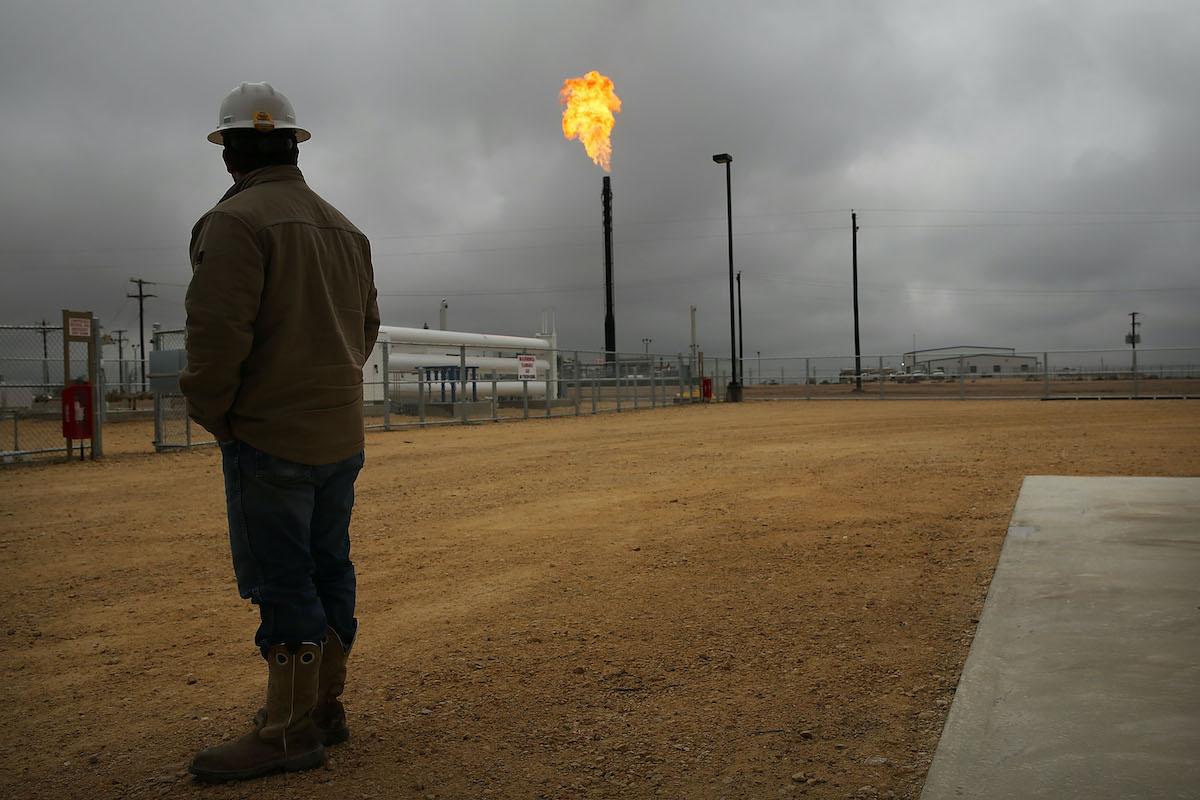Texas Snowstorms Drove Refineries to Emit Massive Amounts of Air Pollutants
Published Feb. 22 2021, 12:54 p.m. ET

People wait in long lines at an H-E-B grocery store in Austin, Texas on Feb.17, 2021.
Last week, Storm Uri shut down power plants all over Texas, and left millions of Texans without electricity and gas, among endless other heartbreaking side effects. One might think all of that would have temporarily reduced pollution in the Lone Star State, but according to new data, the events from the storm caused oil refineries to release staggering amounts of air pollution across Texas.

Flared natural gas is burned off at Apache Corporations operations at the Deadwood natural gas plant in the Permian Basin on Feb. 5, 2015 in Garden City, Texas.
Why were Texas power plants shut down?
Texas has its own power grid — and the infrastructure of its grid, power plants, and other energy sources are designed for the high temperatures typical to Texas. So when temperatures dropped below freezing and the snowstorm hit, various power plants were shut down, as they weren't weatherproofed to withstand ice and snow. This caused homes around the state to lose electricity, heat, and gas.
Texas refineries quickly resorted to gas flaring during the storms, resulting in air pollution.
As explained by Reuters, as refineries shut down their power plants last week, employees were instructed to perform gas flaring to prevent damage to their machinery.
The amount of gas pollution was astronomical. According to TCEQ data, the state’s five biggest refineries emitted almost 337,000 pounds of pollutants, including benzene, carbon monoxide, hydrogen sulfide, and sulfur dioxide. Between Monday, Feb. 15 and Thursday, Feb. 18, Motiva’s Port Arthur refinery alone emitted 118,100 pounds of pollutants, which is over three times the surplus pollutants it emitted in 2019, Reuters noted.
And in the Houston area last week, refineries burned over 703,000 pounds of pollutants, New York Magazine added.
Many of these pollutants were emitted on Monday, Feb. 15, the day the storms began — for instance, in a span of under five hours on Monday, one Texas refinery (owned by Marathon Petroleum Corp) emitted 14,255 pounds of pollutants, per Reuters.
What is gas flaring? The polluting practice is common in Texas.
Gas flaring is the process of burning and releasing natural gas into the air, according to the University of Calgary. The process results in flames seemingly engulfing the sky and pollutants (that can affect human health) entering the air.
So why are refineries conducting gas flaring in the first place? Natural gas pockets often form and settle above oil in refineries, leading miners typically extract and sell that natural gas as a byproduct of the oil extraction process. However, in Texas, it’s cheaper to simply get rid of that gas rather than sell it, so it’s common practice for Texas miners to flare gas instead.
It’s no surprise that Texas refineries resorted to the environmentally-damaging practice amidst the storms this month, especially considering arguments from companies that had they not flared the gas, their machinery would have been damaged. However, the cost of replacing broken machinery is nothing compared to the environmental costs of dealing with pollution from last week’s gas flaring party.
Gas flaring disproportionately hurts BIPOC communities.
A 2020 study published in the journal Environmental Health Perspectives found that pregnant people who lived near nightly gas flares tended to have a 50 percent higher chance of giving birth prematurely (and other adverse birth outcomes), in comparison to parents who did not live in near gas flares.
The researchers only found a correlation between gas flaring and adverse birth outcomes in Hispanic women, who represented 55 percent of the study sample, which is a perfect example of environmental racism. Oil refineries and other polluting facilities (such as factory farms, landfills, and slaughterhouses) are typically built near BIPOC neighborhoods, unjustly causing public health issues amongst these communities.
The U.S. is one of the world’s top offenders when it comes to gas flaring. For example, in 2018, the U.S., Iraq, Iran, and Algeria conducted more than half of worldwide gas flaring, as per the IEA.
People in Texas are still in need after the horrible storms last week — check out our list of places to donate to help Texas.